A Musician's Analysis of Engine Notes
While I’m a huge petrolhead, I’m also a musician, and I’ve decided to combine these two passions to explain why car engines sound the way they do. I hope that even if you aren’t musical, you can still get something out of this blog.
While I’m a huge petrolhead, I’m also a musician, and I’ve decided to combine these two passions to explain why car engines sound the way they do. I hope that even if you aren’t musical, you can still get something out of this blog.
The fundamental note
In a car engine, the crankshaft turns which provides a fundamental tone. The pitch of this tone depends on the speed of the engine. This is why a Formula One car usually has a higher pitched sound than a normal car. This diagram shows how the engine sounds vary:
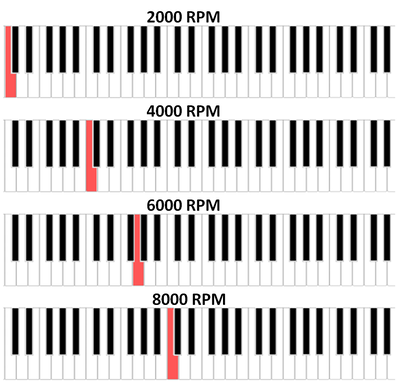
The number of cylinders
There is a secondary engine note caused by the ignition of fuel inside the cylinders. In a four-stroke engine, each cylinder gets an ignition every other stroke, meaning a 4-cylinder engine has a total of two ignitions per revolution. This makes the second exhaust note an octave higher. In a 6-cylinder engine, there are 3 ignitions per revolution which produces that distinctive 6-cylinder sound. Here’s the diagram:
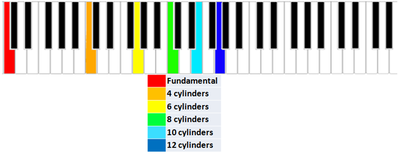
If you play the fundamental note and any of these other notes on the piano, you will find that it (vaguely) resembles the engine note of that cylinder layout. That’s science in action!
Rotary engines tend to vary depending on the number of rotors and their arrangement, but for a single rotor there are three ignitions per rotor revolution.
Why does it sound so good?
All of these chords are pleasing to the ear because they are made up of nice, simple ratios. As you can see from the diagram below, the final waveform (shown in blue) reaches zero (the black line) at the same time as the fundamental note (shown in red) does. This is good. If they were out of synch, you’d hear strange beating noises as the sounds interfere, which is what makes something sound dischordant.
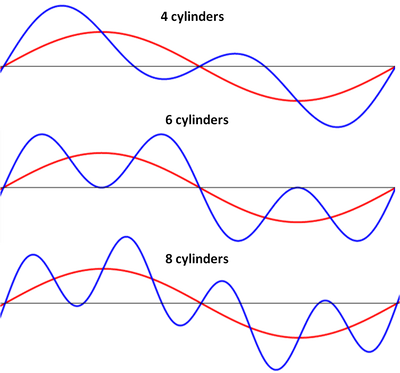
Differences between engines
Not every 6-cylinder engine will sound the same. This is because of harmonics. Most engine notes will not consist of just two tones - they will have other quieter tones called harmonics mixed in. Think of them as different food seasonings - they change the flavour of the note. Harmonics are affected by:
- Layout - inline, V and flat engines produce different harmonics. The angle between the banks in a V engine also affect what harmonics are produced.
- RPM - as the RPM gets higher, the friction on the crankshaft and other mechanical parts increases, producing more of the fundamental note. However the volume of the ignitions doesn’t increase (there are more of them though). If you listen to some V10 Formula One cars, the high-pitched secondary note sometimes gets drowned out by the lower-pitched fundamental as the engine nears redline.
- Exhaust system - small differences in the exhaust’s shape can affect what harmonics are produced. Some car manufacturers and aftermarket exhaust providers will tune an exhaust to favour certain harmonics.
This means that not every V12 sounds the same. Have a look at the sound profiles from these two cars. The darker the red, the more prominent the sound peak is:
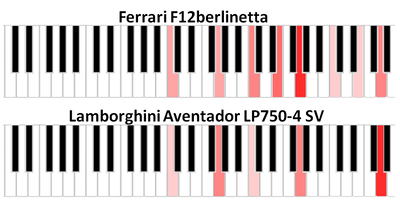
The Ferrari has a huge range of harmonics which gives it a warm, rich sound. On the other hand, the Lamborghini has fewer harmonics and they are all either Cs or Gs. This makes the sound sharp and piercing.
Now for some V10s. Let’s compare two of my favourite V10s:
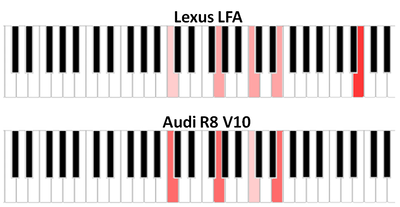
Both cars have mostly the same harmonics, but the guys at Lexus and Yamaha clearly tuned the exhaust to really boost that top harmonic, making the LFA scream like an F1 car. While the R8 sounds great, it doesn’t have that high-pitched shriek that makes the LFA so awesome.
In general, engines with 8 or more cylinders have a major harmonic at three times the fundamental note (like a 6-cylinder) which gives it a warm sound. Both of the above V10s have this, but the Audi’s note is more prominent. Also, a few engines have another harmonic at 5 times the fundamental (like a V10) which is present in the Ferrari V12 we saw earlier.
Even-firing vs odd-firing
Another major difference between engines is whether they are even-firing or odd-firing. In an even-firing engine, each firing is the same amount of time after the previous one. That means one firing every 180 degrees in a 4-cylinder, 120 degrees for 6 cylinders, 90 for 8 and so on. Note that all this is for four-stroke engines only. Even-firing engines tend to produce a smooth sound.
However, it isn’t always easy to make an engine even-firing. If you try to do this with a V10, you have to make the crankshaft a very weird shape and you’re basically restricted to a V-angle of 72 degrees. So some engines are odd-firing which means some firings are closer together than others. This creates an uneven stream of exhaust pulses which makes a throaty burbling noise. Some motorbike tuners take this to the extreme with the “Big Bang” firing order which fires all the cylinders in a very short space of time.
A related concept is the difference between a cross-plane and a flat-plane V8. Cross-plane engines have a different firing order which also results in those burbles. This is why a Chevy V8 makes a rich, warm sound whereas a Porsche 918 makes a higher-pitched, smooth sound. Although Ferrari and Maserati V8s are somewhat related, Ferraris are flat-plane and Maseratis are cross-plane - the difference in sound is stark.
I hope you learned something and enjoyed reading this blog :D!













Comments
So refreshing to see a fellow musician! I take it you do piano? If so what grade?
I recently took my ARSM which is between ABRSM Grade 8 and the first level of diploma. How about you?
This is an awesome article analysis!!
Pretty good post!
Don’t think I’ve seen anything like this on CT prior (in a good way obv)
This is just wow
Is there a way to listen to these?
Unfortunately not unless you play them on a keyboard or synthesiser program or something.
Let’s all take a minute to soak in and appreciate the fact that someone spent time and analysed certain car’s exhaust sound and explain them as notes, and music…this can bring a tear to your eye… this is THE PERFECT topic to use and brilliantly explain what cars mean to us all…im touched.
I’m a car guy and I play trumpet. I find this very interesting.
Really good post TheMindGarage
Love your work!
This is great! Reminds me of when I used to imitate F1 noises on the guitar by sliding across the higher frets
is this why the LFA has a 72 degree bank angle? because it’s an even-firing engine?
Pagination